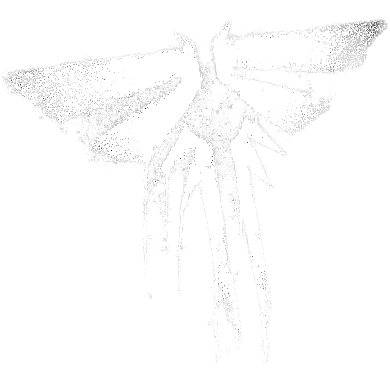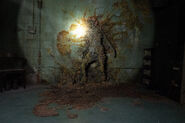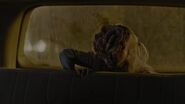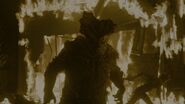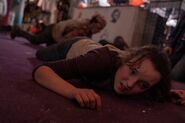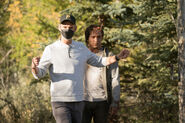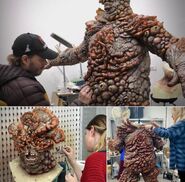The infected are humans who have been infected by the Cordyceps brain infection and subsequently mutated into horrific new forms in HBO's The Last of Us. The resulting creatures are aggressive and will attack any uninfected human on sight.[1]
History[]
In 2003, a subspecies of Cordyceps or Ophiocordyceps, a parasitic fungus known to only infect insects such as ants and caterpillars, was able to rapidly evolve due to Earth's temperature increasing. Initially unable to infect humans due to their higher body temperatures, this new strain of evolved Cordyceps was resistant to such temperatures, and thus was able to use humans as hosts. As such, in the summer of 2003, the Cordyceps brain infection outbreak occurred.[1] Starting in Jakarta, Indonesia, the infection rapidly spread to the United States and the rest of the world, causing a complete breakdown of global civilization. The fungus infected humans primarily through yeast products like flour and food created from it, like cookies and bread.[2]
Once infected, early symptoms of the infection include coughing, slurred speech, muscle spasms, and increased aggression. The fungus eventually hijacks the host's motor functions and takes control of their body, turning them violently aggressive. Relying on warped instincts, they are compelled to attack and infect other people in order to spread the infection via tendrils that sprouted from the mouth. The infected also seem to be all linked together as a hive mind due to the network of Cordyceps mycilium growing underground. Disturbing one patch of the fungus could awaken another one with a horde of infected hosts lying dormant up to one mile away.
Dogs are capable of detecting the infection within a human even before the fungus takes control of the host. Connie Adler's dog, Mercy, was able to detect the changes occurring in Nana and, upon her turning into an infected, became frightened by her and instinctively desired to stay away from her.[1] The Jackson community had their patrols assisted by dogs to help determine whether or not survivors entering their lands were infected; if they reacted negatively, the patrolmen would kill the survivors.[3]
When passive, many infected tend to lie down in an area and allow the fungus to emit and grow from their body. The fungus gradually attaches them to the environment around them until they eventually stick to the floor or walls, becoming a breeding ground for the Cordyceps until they eventually die. If the fungus has dried, it usually indicates that the infected hosts inside are dead.[2] This process can take weeks or even months.[1] According to Joel, these inert hordes of infected tend to only appear in highly populated areas like cities, with the countryside being too remote for such large hordes to form.[4] Indeed, the isolated town of Lincoln only had the occasional wandering infected.[5]
However, not every infected remains as passive. While most do go on to die and become a permanent breeding ground, a rare few progress even further. Because of the continued development of fungal growth throughout the body, especially around the face, the infected eventually go blind as the fungus grows over or outright destroys the host's eyes. Because of this blindness, they develop a heightened sense of echolocation, generating croaking and clicking noises to detect sounds and objects in their environment. According to Ellie, she heard stories that there is a further stage that can throw spore projectiles at its target.[2]
The infected are sometimes able to sense whether or not someone is infected and, depending on the severity, may choose to help accelerate the process. After Tess was infected, one of the infected spotted her, but did not attack; rather, it came up to her to transfer some hyphae from his mouth to hers as if it were a kiss to help speed up the infection process. On the other hand, they would not hesitate to attack Ellie, who is infected with the fungus but immune to its effects.[2]
Variants[]
Stage one[]
Those in the early stages of infection still closely resemble humans. Visually, their eyes are bloodshot and dilated, and clusters of veins can be seen pulsating through the skin.[1] Most notably, dozens of slender tendrils, formed from hyphae,[6] will begin to emerge from the mouth.[1] It is through these tendrils that they spread the infection to other humans via bites.[2]
As humans under the control of the Cordyceps fungus, these infected exhibits warped, animalistic behavior. As the fungus has hijacked their motor controls, they often display violent muscle spasms, and they will often scream and gasp heavily, especially when spotting prey. Highly aggressive and active, these infected are compelled by the fungus to attack non-infected humans. This urge removes any sense of self-preservation, and the host will sprint and leap at their target even if it leads to self-injury or death. They consequently lack fine motor control, typically overrunning their targets, and stumbling or crashing into objects or walls. Despite this, they recover quickly and will keep chasing their prey at high speeds. Their feral nature does make them predictable, making them easy to kill with traps or weapons[1] and even fire.
Stage two[]
Those in the later stages of infection somewhat resemble humans. The hyphae grow under the skin, creating noticeable bumps and grooves, and fungal plates emerge from the skin, along with an unknown green discharge. The infected's eyes and skin turn yellow at this stage. The most notable characteristic of this stage, however, is that the fungus has started to emerge from the infected's eyes in a truly disfiguring fashion.[2][7]
Clicker[]
Those who have been infected for a longer period of time can become horrifically deformed by the infection. Due to the advanced fungal growth on their brains, the skull has been split in two to allow continued growth, leaving their faces completely skewed and scarred, only leaving behind a maw of jagged teeth. The excessive fungal growth has left them blind, forcing them to develop a rudimentary and crude form of echolocation to "see" their surroundings, which has earned them the name "clickers" for the distinctive clicking sound. By this point, whatever clothes the host may have been wearing are mostly tattered and destroyed. Unlike the previous two stages, the clicker lacks the fungal tendrils that were originally present in the host's mouth.
Clickers have large patches of rashes all over their body as well as small fungal growths, creating large patches of scale-like tissue coming from outside their host's bodies, especially their necks and shoulders. They croak and whine when unaware, limping around their space. When they do hear noises, however, they rush towards the source of the sound. They are fast, able to sprint and leap over obstacles with enough force to knock people down—one managed to tackle both Joel and Ellie at the same time. Once they have found their target, their go-to attack is to disarm their prey and either savagely maul them to death or tear their throat out with their teeth.
They also have enhanced strength and durability—one could withstand multiple gunshots to the body from Joel's assault rifle, while another still had the strength to knock Tess backward after she hacked into its armor-plated head with an axe. Despite this, they could be killed by multiple gunshots to the head, the bullets from Joel's revolver able to pierce the fungal growth and kill two infected. Given their rarity in and around quarantine zones, FEDRA schools did not teach their students about the clickers, although Ellie had heard rumors about them.[2] According to Henry Burrell, surviving an attack from one clicker was an incredible feat for survivors to achieve, expressing his astonishment when Ellie informed him Joel saved her from two clickers in Boston.[8]
Bloater[]
Bloaters are an even rarer, advanced stage of infected that succeeds the clicker stage. It takes the longest amount of time to occur and is subsequently the most powerful and largest known variant because the host has to be strong enough to survive the extensive infection. They are enormous in size, easily towering over the humans around them. The fungus has grown to an excessive degree, causing the body to bloat and forming fungal plates that act as body armor against attacks. This fungal armor is able to withstand barrages of bullets from assault rifles.
Bloaters possess incredible strength; they could kill people with a single punch and rip them apart with ease, such as their signature jaw-breaking attack. It is also said that they are capable of throwing spore projectiles at people, though it has yet to be verified due their rarity. Despite their immense size and strength, they are noticeably slower than the earlier infected variants, who can easily outrun them. Unlike the lesser infected who tend bite the uninfected, bloaters do not seem to be compelled to do so, as they outright kill them instead.[8]
Behind the scenes[]
- In the video game series, and out-of-universe merchandise, the early stages of infected are referred to as runners and stalkers, and the late stage infected are referred to as clickers and bloaters. To date, the only term that has been used in-universe is "clickers" in "Endure and Survive", although the other names were used on-set and in interviews. Further, stalkers are the only stage not named in credits for the series.
- While the museum clickers are physically portrayed by Olivier-Ross Parent and Samuel Hoeksema, voice actors Misty Lee and Phillip Kovats reprise their roles from the game as the clickers' distinctive noise.[9]
- The team behind The Last of Us spent a great deal of time during pre-production figuring out how to accurately portray the clickers. It was decided early on that they would be portrayed with prosthetics rather than visual effects, as Craig Mazin felt not having the physical creature would lessen the impact. The clickers were designed by Barrie and Sarah Gower, who previously worked with Mazin on Chernobyl. The designers frequently referenced art from the game in the process. Mazin noted it was important for veteran players of the franchise to recognize the clickers as the enemy they encountered in the game, and for new viewers to be terrified. The actors hired to play the clickers were fans of the game, and so were able to mimic the movements as well as make the noises during filming, though this was dubbed over in post-production.[6][10] Both Bella Ramsey (Ellie) and Pedro Pascal (Joel) found filming the museum sequence in "Infected" immersive and terrifying due to having the clickers on-set and having to react in real time: Ramsey opined she did not have to act very much as she was genuinely scared by the clickers' appearance and movements.[11][12]
- The child clicker in "Endure and Survive" also marks the first time a child at this stage of infection is seen in The Last of Us franchise. This was an intentional choice by Craig Mazin, who wanted to contrast innocence with horror.[13] She was played by contortionist Skye Belle-Cowton who was 9 at the time of filming.
- The bloater from "Endure and Survive" was a mix between a practical suit, and CG imaging. The CG model was made by WETA FX, and the practical suit was played by Adam Basil. [14]
Gallery[]
Official stills[]
Behind the scenes[]
References[]
- ↑ 1.0 1.1 1.2 1.3 1.4 1.5 1.6 HBO's The Last of Us episode 1: "When You're Lost in the Darkness"
- ↑ 2.0 2.1 2.2 2.3 2.4 2.5 2.6 HBO's The Last of Us episode 2: "Infected"
- ↑ HBO's The Last of Us episode 6: "Kin"
- ↑ HBO's The Last of Us episode 4: "Please Hold to My Hand"
- ↑ HBO's The Last of Us episode 3: "Long, Long Time"
- ↑ 6.0 6.1 "The Last of Us, Inside the Episode - 2". HBO. January 22, 2023. Retrieved January 23, 2023.
- ↑ HBO's The Last of Us episode 3: "Long, Long Time"
- ↑ 8.0 8.1 HBO's The Last of Us episode 5: "Endure and Survive"
- ↑ Thomas, Michael (January 23, 2023). "The Last of Us Episode 2 Easter Eggs". Collider. Retrieved January 23, 2023.
- ↑ Moreau, Jordan (January 22, 2023). "‘The Last of Us’ Creators on THAT Clicker Moment, Flour Theories and Changes From the Game: ‘If People Are Upset, I Don’t Blame Them’ (EXCLUSIVE)". Variety. Retrieved January 24, 2023.
- ↑ Deckelmeier, Joe (January 6, 2023). "Pedro Pascal & Bella Ramsey Interview: The Last Of Us". Screen Rant. Retrieved January 23, 2023.
- ↑ Ryan, Patrick (January 23, 2023). "'The Last of Us' star Bella Ramsey worries that she loves the Clickers 'a bit too much'". USA Today. Retrieved January 23, 2023.
- ↑ HBO's The Last of Us Podcast episode 5: "Endure and Survive"
- ↑ 'The Last of US' HBO VFX Exclusive, Tech Crunch. Accessed July 14, 2023
